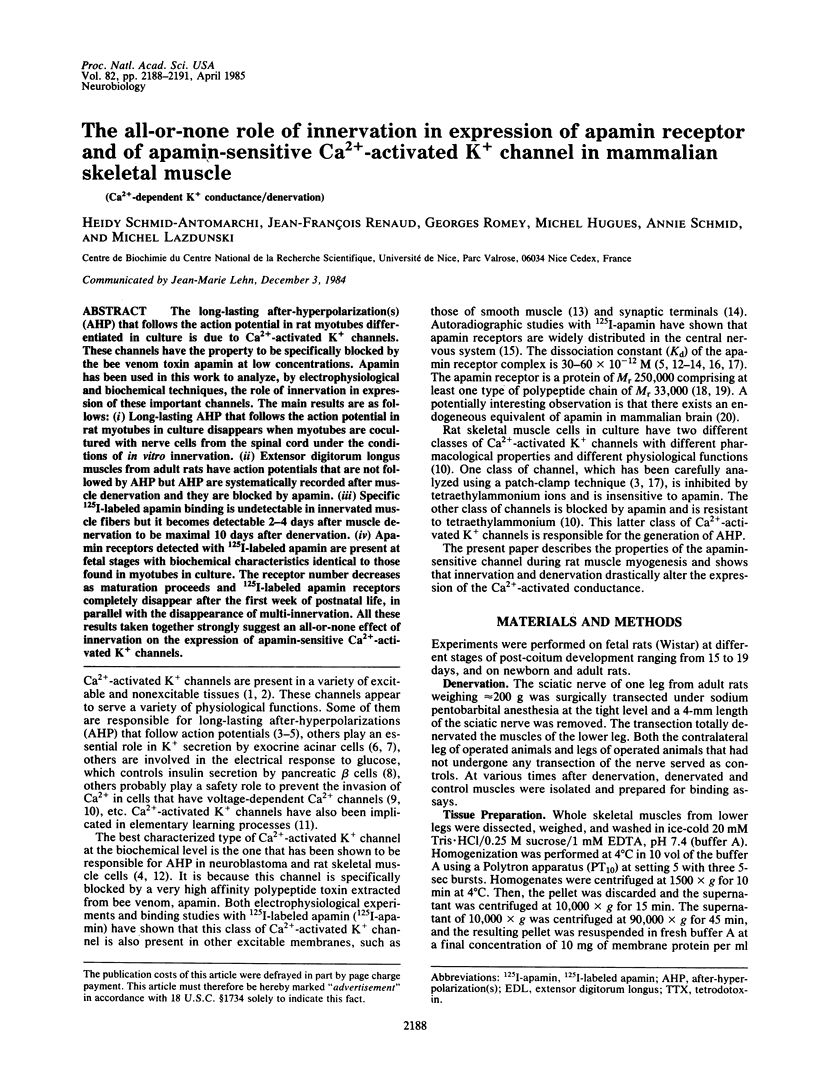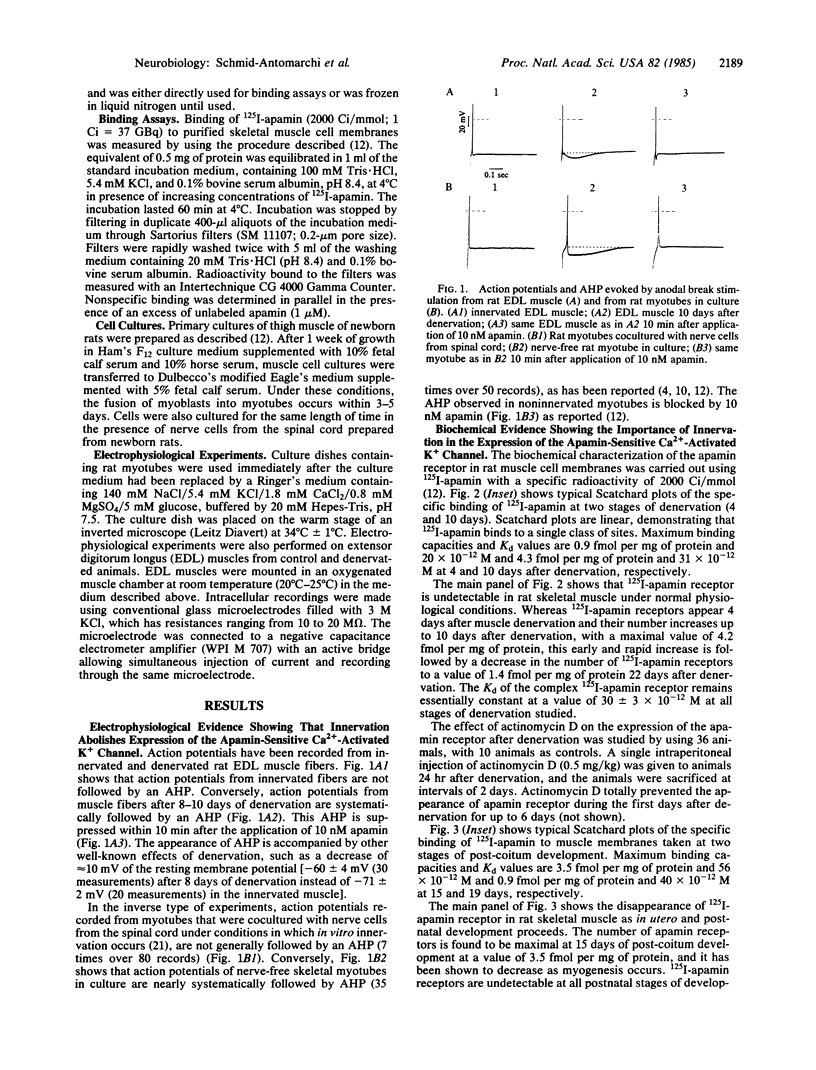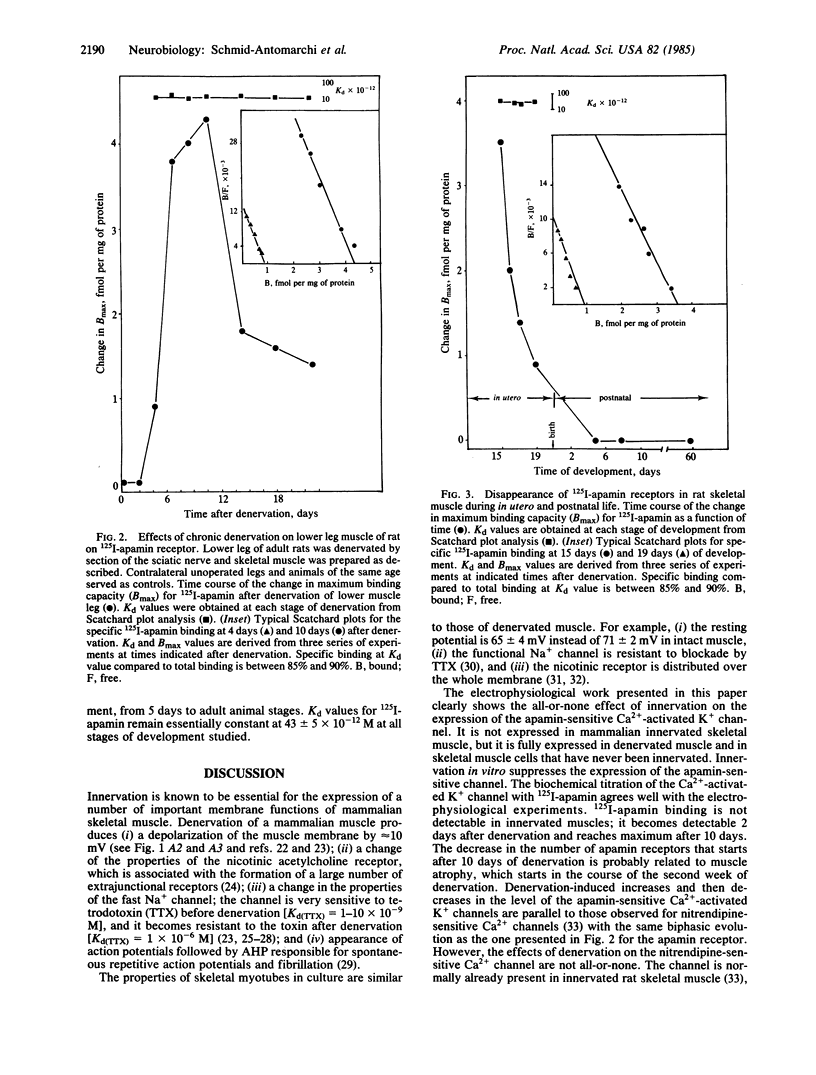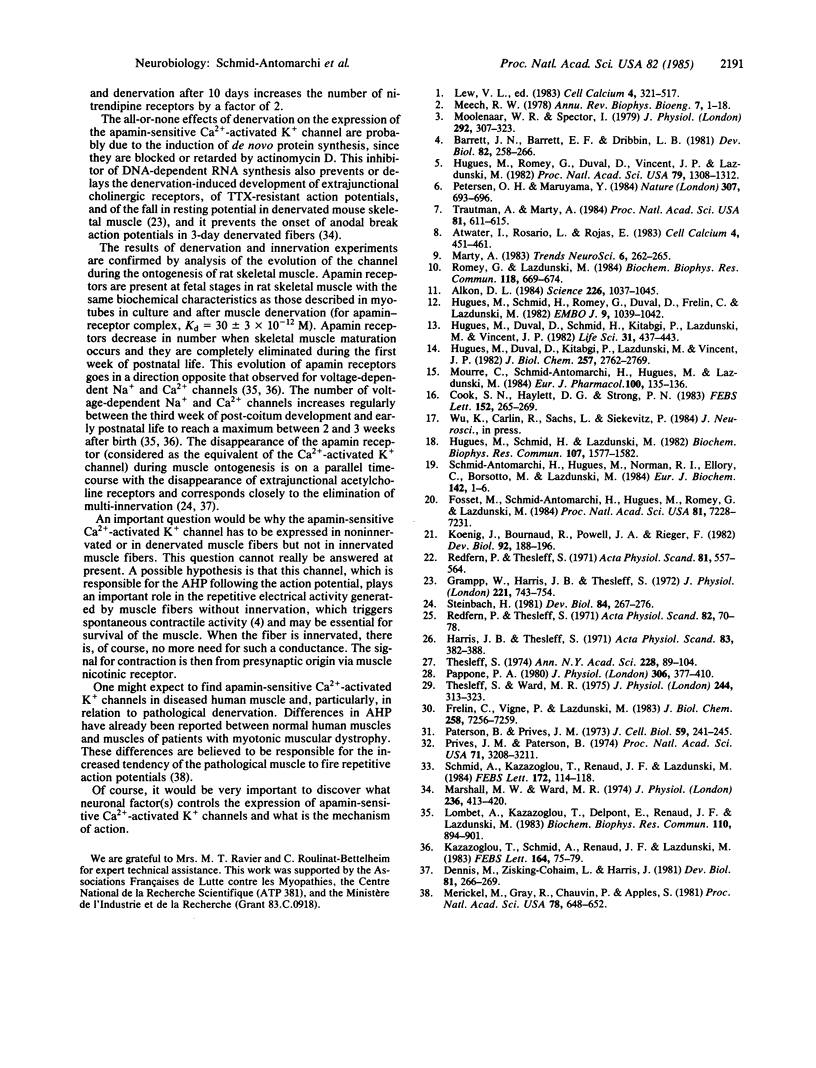Abstract
The long-lasting after-hyperpolarization(s) (AHP) that follows the action potential in rat myotubes differentiated in culture is due to Ca2+-activated K+ channels. These channels have the property to be specifically blocked by the bee venom toxin apamin at low concentrations. Apamin has been used in this work to analyze, by electrophysiological and biochemical techniques, the role of innervation in expression of these important channels. The main results are as follows: (i) Long-lasting AHP that follows the action potential in rat myotubes in culture disappears when myotubes are cocultured with nerve cells from the spinal cord under the conditions of in vitro innervation. (ii) Extensor digitorum longus muscles from adult rats have action potentials that are not followed by AHP but AHP are systematically recorded after muscle denervation and they are blocked by apamin. (iii) Specific 125I-labeled apamin binding is undetectable in innervated muscle fibers but it becomes detectable 2-4 days after muscle denervation to be maximal 10 days after denervation. (iv) Apamin receptors detected with 125I-labeled apamin are present at fetal stages with biochemical characteristics identical to those found in myotubes in culture. The receptor number decreases as maturation proceeds and 125I-labeled apamin receptors completely disappear after the first week of postnatal life, in parallel with the disappearance of multi-innervation. All these results taken together strongly suggest an all-or-none effect of innervation on the expression of apamin-sensitive Ca2+-activated K+ channels.
Full text
PDF



Selected References
These references are in PubMed. This may not be the complete list of references from this article.
- Alkon D. L. Calcium-mediated reduction of ionic currents: a biophysical memory trace. Science. 1984 Nov 30;226(4678):1037–1045. doi: 10.1126/science.6093258. [DOI] [PubMed] [Google Scholar]
- Atwater I., Rosario L., Rojas E. Properties of the Ca-activated K+ channel in pancreatic beta-cells. Cell Calcium. 1983 Dec;4(5-6):451–461. doi: 10.1016/0143-4160(83)90021-0. [DOI] [PubMed] [Google Scholar]
- Barrett J. N., Barrett E. F., Dribin L. B. Calcium-dependent slow potassium conductance in rat skeletal myotubes. Dev Biol. 1981 Mar;82(2):258–266. doi: 10.1016/0012-1606(81)90450-4. [DOI] [PubMed] [Google Scholar]
- Cook N. S., Haylett D. G., Strong P. N. High affinity binding of [125I]monoiodoapamin to isolated guinea-pig hepatocytes. FEBS Lett. 1983 Feb 21;152(2):265–269. doi: 10.1016/0014-5793(83)80393-7. [DOI] [PubMed] [Google Scholar]
- Dennis M. J., Ziskind-Conhaim L., Harris A. J. Development of neuromuscular junctions in rat embryos. Dev Biol. 1981 Jan 30;81(2):266–279. doi: 10.1016/0012-1606(81)90290-6. [DOI] [PubMed] [Google Scholar]
- Fosset M., Schmid-Antomarchi H., Hugues M., Romey G., Lazdunski M. The presence in pig brain of an endogenous equivalent of apamin, the bee venom peptide that specifically blocks Ca2+-dependent K+ channels. Proc Natl Acad Sci U S A. 1984 Nov;81(22):7228–7232. doi: 10.1073/pnas.81.22.7228. [DOI] [PMC free article] [PubMed] [Google Scholar]
- Frelin C., Vigne P., Lazdunski M. Na+ channels with high and low affinity tetrodotoxin binding sites in the mammalian skeletal muscle cell. Difference in functional properties and sequential appearance during rat skeletal myogenesis. J Biol Chem. 1983 Jun 25;258(12):7256–7259. [PubMed] [Google Scholar]
- Grampp W., Harris J. B., Thesleff S. Inhibition of denervation changes in skeletal muscle by blockers of protein synthesis. J Physiol. 1972 Mar;221(3):743–754. doi: 10.1113/jphysiol.1972.sp009780. [DOI] [PMC free article] [PubMed] [Google Scholar]
- Harris J. B., Thesleff S. Studies on tetrodotoxin resistant action potentials in denervated skeletal muscle. Acta Physiol Scand. 1971 Nov;83(3):382–388. doi: 10.1111/j.1748-1716.1971.tb05091.x. [DOI] [PubMed] [Google Scholar]
- Hugues M., Duval D., Kitabgi P., Lazdunski M., Vincent J. P. Preparation of a pure monoiodo derivative of the bee venom neurotoxin apamin and its binding properties to rat brain synaptosomes. J Biol Chem. 1982 Mar 25;257(6):2762–2769. [PubMed] [Google Scholar]
- Hugues M., Duval D., Schmid H., Kitabgi P., Lazdunski M., Vincent J. P. Specific binding and pharmacological interactions of apamin, the neurotoxin from bee venom, with guinea pig colon. Life Sci. 1982 Aug 2;31(5):437–443. doi: 10.1016/0024-3205(82)90328-9. [DOI] [PubMed] [Google Scholar]
- Hugues M., Romey G., Duval D., Vincent J. P., Lazdunski M. Apamin as a selective blocker of the calcium-dependent potassium channel in neuroblastoma cells: voltage-clamp and biochemical characterization of the toxin receptor. Proc Natl Acad Sci U S A. 1982 Feb;79(4):1308–1312. doi: 10.1073/pnas.79.4.1308. [DOI] [PMC free article] [PubMed] [Google Scholar]
- Hugues M., Schmid H., Lazdunski M. Identification of a protein component of the Ca2+-dependent K+ channel by affinity labelling with apamin. Biochem Biophys Res Commun. 1982 Aug 31;107(4):1577–1582. doi: 10.1016/s0006-291x(82)80180-0. [DOI] [PubMed] [Google Scholar]
- Hugues M., Schmid H., Romey G., Duval D., Frelin C., Lazdunski M. The Ca2+-dependent slow K+ conductance in cultured rat muscle cells: characterization with apamin. EMBO J. 1982;1(9):1039–1042. doi: 10.1002/j.1460-2075.1982.tb01293.x. [DOI] [PMC free article] [PubMed] [Google Scholar]
- Kazazoglou T., Schmid A., Renaud J. F., Lazdunski M. Ontogenic appearance of Ca2+ channels characterized as binding sites for nitrendipine during development of nervous, skeletal and cardiac muscle systems in the rat. FEBS Lett. 1983 Nov 28;164(1):75–79. doi: 10.1016/0014-5793(83)80022-2. [DOI] [PubMed] [Google Scholar]
- Koenig J., Bournaud R., Powell J. A., Rieger F. Appearance of contractile activity in muscular dysgenesis (mdg/mdg) mouse myotubes during coculture with normal spinal cord cells. Dev Biol. 1982 Jul;92(1):188–196. doi: 10.1016/0012-1606(82)90162-2. [DOI] [PubMed] [Google Scholar]
- Lew V. L., Muallem S., Seymour C. A. The Ca-activated K channel of human red cells: all or none behaviour of the Ca2+-gating mechanism. Cell Calcium. 1983 Dec;4(5-6):511–517. doi: 10.1016/0143-4160(83)90026-x. [DOI] [PubMed] [Google Scholar]
- Lombet A., Kazazoglou T., Delpont E., Renaud J. F., Lazdunski M. Ontogenic appearance of Na+ channels characterized as high affinity binding sites for tetrodotoxin during development of the rat nervous and skeletal muscle systems. Biochem Biophys Res Commun. 1983 Feb 10;110(3):894–901. doi: 10.1016/0006-291x(83)91046-x. [DOI] [PubMed] [Google Scholar]
- Marshall M. W., Ward M. R. Anode break excitation in denervated rat skeletal muscle fibres. J Physiol. 1974 Jan;236(2):413–420. doi: 10.1113/jphysiol.1974.sp010443. [DOI] [PMC free article] [PubMed] [Google Scholar]
- Meech R. W. Calcium-dependent potassium activation in nervous tissues. Annu Rev Biophys Bioeng. 1978;7:1–18. doi: 10.1146/annurev.bb.07.060178.000245. [DOI] [PubMed] [Google Scholar]
- Merickel M., Gray R., Chauvin P., Appel S. Cultured muscle from myotonic muscular dystrophy patients: altered membrane electrical properties. Proc Natl Acad Sci U S A. 1981 Jan;78(1):648–652. doi: 10.1073/pnas.78.1.648. [DOI] [PMC free article] [PubMed] [Google Scholar]
- Moolenaar W. H., Spector I. The calcium current and the activation of a slow potassium conductance in voltage-clamped mouse neuroblastoma cells. J Physiol. 1979 Jul;292:307–323. doi: 10.1113/jphysiol.1979.sp012852. [DOI] [PMC free article] [PubMed] [Google Scholar]
- Mourre C., Schmid-Antomarchi H., Hugues M., Lazdunski M. Autoradiographic localization of apamin-sensitive Ca2+-dependent K+ channels in rat brain. Eur J Pharmacol. 1984 Apr 13;100(1):135–136. doi: 10.1016/0014-2999(84)90329-7. [DOI] [PubMed] [Google Scholar]
- Pappone P. A. Voltage-clamp experiments in normal and denervated mammalian skeletal muscle fibres. J Physiol. 1980 Sep;306:377–410. doi: 10.1113/jphysiol.1980.sp013403. [DOI] [PMC free article] [PubMed] [Google Scholar]
- Paterson B., Prives J. Appearance of acetylcholine receptor in differentiating cultures of embryonic chick breast muscle. J Cell Biol. 1973 Oct;59(1):241–245. doi: 10.1083/jcb.59.1.241. [DOI] [PMC free article] [PubMed] [Google Scholar]
- Petersen O. H., Maruyama Y. Calcium-activated potassium channels and their role in secretion. Nature. 1984 Feb 23;307(5953):693–696. doi: 10.1038/307693a0. [DOI] [PubMed] [Google Scholar]
- Prives J. M., Paterson B. M. Differentiation of cell membranes in cultures of embryonic chick breast muscle. Proc Natl Acad Sci U S A. 1974 Aug;71(8):3208–3211. doi: 10.1073/pnas.71.8.3208. [DOI] [PMC free article] [PubMed] [Google Scholar]
- Redfern P., Thesleff S. Action potential generation in denervated rat skeletal muscle. I. Quantitative aspects. Acta Physiol Scand. 1971 Apr;81(4):557–564. doi: 10.1111/j.1748-1716.1971.tb04932.x. [DOI] [PubMed] [Google Scholar]
- Redfern P., Thesleff S. Action potential generation in denervated rat skeletal muscle. II. The action of tetrodotoxin. Acta Physiol Scand. 1971 May;82(1):70–78. doi: 10.1111/j.1748-1716.1971.tb04943.x. [DOI] [PubMed] [Google Scholar]
- Romey G., Lazdunski M. The coexistence in rat muscle cells of two distinct classes of Ca2+-dependent K+ channels with different pharmacological properties and different physiological functions. Biochem Biophys Res Commun. 1984 Jan 30;118(2):669–674. doi: 10.1016/0006-291x(84)91355-x. [DOI] [PubMed] [Google Scholar]
- Schmid-Antomarchi H., Hugues M., Norman R., Ellory C., Borsotto M., Lazdunski M. Molecular properties of the apamin-binding component of the Ca2+-dependent K+ channel. Radiation-inactivation, affinity labelling and solubilization. Eur J Biochem. 1984 Jul 2;142(1):1–6. doi: 10.1111/j.1432-1033.1984.tb08242.x. [DOI] [PubMed] [Google Scholar]
- Schmid A., Kazazoglou T., Renaud J. F., Lazdunski M. Comparative changes of levels of nitrendipine Ca2+ channels, of tetrodotoxin-sensitive Na+ channels and of ouabain-sensitive (Na+ + K+)-ATPase following denervation of rat and chick skeletal muscle. FEBS Lett. 1984 Jun 25;172(1):114–118. doi: 10.1016/0014-5793(84)80885-6. [DOI] [PubMed] [Google Scholar]
- Thesleff S. Trophic functions of the neuron. II. Denervation and regulation of muscle. Physiological effects of denervation of muscle. Ann N Y Acad Sci. 1974 Mar 22;228(0):89–104. doi: 10.1111/j.1749-6632.1974.tb20504.x. [DOI] [PubMed] [Google Scholar]
- Thesleff S., Ward M. R. Studies on the mechanism of fibrillation potentials in denervated muscle. J Physiol. 1975 Jan;244(2):313–323. doi: 10.1113/jphysiol.1975.sp010800. [DOI] [PMC free article] [PubMed] [Google Scholar]
- Trautmann A., Marty A. Activation of Ca-dependent K channels by carbamoylcholine in rat lacrimal glands. Proc Natl Acad Sci U S A. 1984 Jan;81(2):611–615. doi: 10.1073/pnas.81.2.611. [DOI] [PMC free article] [PubMed] [Google Scholar]


